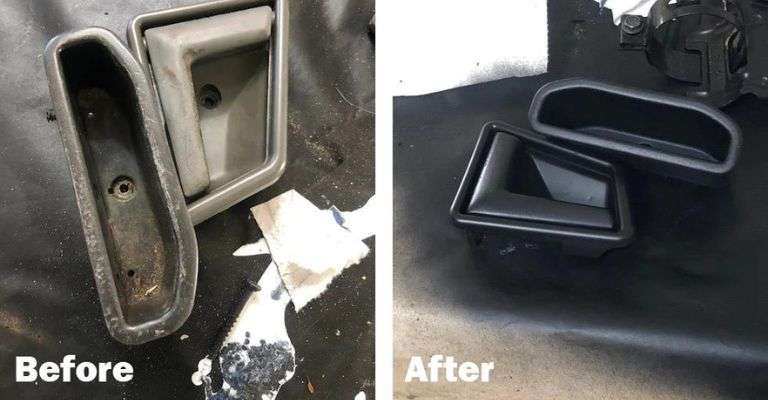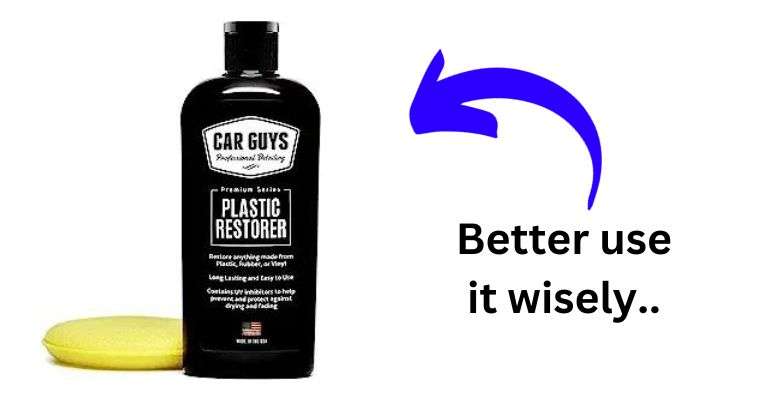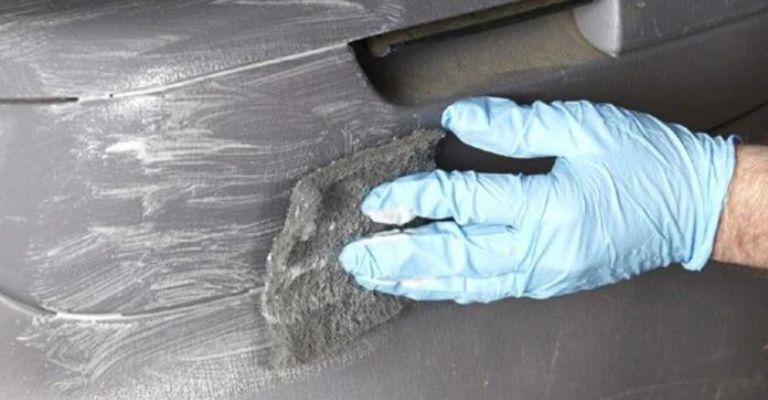Last Updated on November 9, 2023 by Chase Manhattan
Does the interior plastic of your car look dull and tired, diminishing the overall appeal of your beloved vehicle? Fear not, you’ve landed at the right place to rejuvenize them!
- How to Clean Car Carpets Quick and Easy - July 10, 2024
- Can You Touch Up Clear Coat? Yes and No (Here’s Why) - November 25, 2023
- How To Wax A Car By Hand: A Comprehensive Guide - November 14, 2023
Discover the magic to restore interior plastics in cars like a true professional. Transform your faded, worn-out interior into a stunning, almost-new facelift, evoking the same excitement as when you first got your keys!
This all-encompassing guide, curated by seasoned experts, will uncomplicate every step for you. Restore your car’s interior beauty and uphold its value without breaking a sweat. After all, every car deserves a second chance to shine, and so does yours. So, gear up, and let’s dive in!
Quick Navigation
Understanding the Importance of Plastic Restoration
Interior plastic restoration is more than just a cosmetic upgrade—it’s an integral part of maintaining your car’s value. The condition of your vehicle’s interior can significantly impact its resale value, making it crucial to keep all components, including plastic parts, in top condition. Additionally, a well-maintained interior enhances your driving experience, providing a clean, comfortable, and aesthetically pleasing environment.
Identifying the Types of Damage
Before embarking on the restoration process, it’s essential to identify the type of damage your car’s interior plastic has sustained. Common issues include:
- Fading: Exposure to sunlight and heat can cause the color of your car’s interior plastic to fade over time.
- Scratches: Sharp objects, pet claws, or general wear and tear can result in scratches or cracks on your car’s interior plastic.
- Stains: Spills or dirt can lead to unsightly stains that mar the appearance of your vehicle’s interior.
Preparatory Steps for Restoration
Before starting the restoration process, prepare your car’s interior by cleaning all plastic surfaces thoroughly. This will remove any dirt, oil, or grime that could interfere with the restoration process. Use a gentle, non-abrasive cleaner suitable for automotive plastics. Avoid using harsh chemicals that could damage the plastic or cause discoloration.

A Step-by-Step Guide to Restoring Interior Plastic in Cars
Restoring the interior plastic in your car involves several steps, from cleaning and repairing scratches to applying a restorative product. Here’s a step-by-step guide:
- Clean the Plastic: Begin by cleaning the plastic surface thoroughly to remove any dirt, oil, or grime.
- Repair Scratches: If there are any scratches on the plastic, use a scratch repair kit or a plastic restoration compound to fill them in.
- Apply a Plastic Restorer: Apply a plastic restorer to the cleaned and repaired plastic surface. This will restore the color and finish of the plastic.
- Buff the Plastic: After applying the restorer, buff the plastic using a soft cloth to remove any excess product and create a smooth, even finish.
For my visual learners out there, check out this video:
The Best Restoration Methods
While there are multiple methods for restoring interior plastic in cars, some prove more effective than others. Here are some of the best restoration methods:
- Painting: Painting is an effective way to restore faded or discolored plastic. Use a paint designed specifically for plastic and ensure that the color matches the original color of the plastic.
- Conditioning: Conditioning products restore the shine and luster to plastic surfaces, making them look like new again. These products also provide a protective layer that helps prevent future fading or discoloration.
- Heat Gun Method: The heat gun method involves heating the plastic until the oils within it rise to the surface, restoring its original color and shine. This method should be used with caution as excessive heat can warp or damage the plastic.
Making the Most of a Restoration Kit
A restoration kit can be a valuable tool when restoring car interior plastic. These kits typically include a cleaner, scratch repair compound, restorer, and applicator tools. To get the best results from a restoration kit:
- Follow the instructions provided with the kit carefully.
- Always clean the plastic surface thoroughly before applying any repair or restoration products.
- Use the included applicator tools to ensure a smooth, even application of the products.
- Allow the products to dry fully before using the car’s interior to prevent smudging or transferring of the product.

The Best Methods for Restoring Light Scratches
For light scratches, a simple cleaning and buffing process may suffice. Begin by cleaning the scratched area thoroughly, then use a microfiber cloth and a bit of toothpaste or baking soda mixed with water to gently buff out the scratch. Rinse and dry the area before applying a layer of plastic restorer or conditioner to seal and protect the surface.
How to Repair Deeper Scratches
Deeper scratches may require a more intensive repair process. You’ll need a plastic scratch repair kit, which typically includes a filler material and a color-matching paint. Follow the instructions provided with the kit to fill in the scratch and paint over the repaired area. Once the paint has dried, apply a plastic restorer or conditioner to seal and protect the surface.
Post-Restoration Care
After restoring the interior plastic in your car, it’s essential to take steps to maintain its appearance. Regular cleaning is crucial—use a gentle, non-abrasive cleaner and a soft cloth to wipe down the plastic surfaces in your car’s interior regularly. Additionally, consider using a UV protectant product to shield your car’s interior plastic from sun damage, which can cause fading or discoloration over time.
Essential Maintenance Tips
Maintaining the restored interior plastic in your car is crucial for preserving its appearance and longevity. Here are some essential maintenance tips:
- Regular Cleaning: Regularly clean your car’s interior plastic using a gentle, non-abrasive cleaner.
- UV Protection: Use a UV protectant product to shield your car’s interior plastic from sun damage, which can cause fading and discoloration.
- Prompt Repair: If you notice any new scratches or damage to the plastic, repair it promptly to prevent it from worsening.
Understanding how to restore interior plastic in cars is a valuable skill that can enhance your vehicle’s appearance and value. Whether you’re dealing with light scratches, deeper scratches, or faded black interior plastic, this guide provides you with the knowledge and techniques you need to effectively restore your car’s interior plastic. Happy restoring!
Frequently Asked Questions
What is the Best Way to Clean Interior Car Plastics Before Restoration?
Begin by wiping down the plastic surfaces with a microfiber cloth to remove dust and loose dirt. Then, use a mild automotive interior cleaner or a mixture of warm water and mild dish soap. Apply the cleaner with a soft brush or cloth, scrub gently, and wipe off with a clean, damp cloth.
Can I Use Household Cleaners for Cleaning Car Interior Plastics?
It’s not recommended to use harsh household cleaners as they can damage the plastic. Stick to automotive interior cleaners or mild soap solutions. Avoid anything with alcohol, bleach, or ammonia.
What Products are Recommended for Restoring Faded Car Interior Plastics?
For restoring faded plastics, use products specifically designed for automotive interiors, such as plastic restorers or trim restorers. These products are formulated to rejuvenate the plastic, improve color, and provide UV protection.
How Do I Apply Plastic Restorer to My Car’s Interior?
First, ensure the plastic is clean and dry. Apply the restorer using a microfiber cloth or foam applicator, rubbing it in evenly. Allow it to soak in for a few minutes, then wipe off any excess product with a clean cloth.
Is It Necessary to Prep the Plastic Before Applying a Restorer?
Yes, prepping the surface is crucial for the restorer to adhere properly. Clean the plastic thoroughly and make sure it’s completely dry before applying any restorative products.

